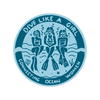Weather — it’s something we often just check the news or MetService for. Here in NZ, with our classic “four seasons in a day” vibes, half the time I just use what I like to call “look up.com” — the simple act of looking at the sky and seeing what the clouds are doing.
But as you might guess, the weather plays a huge role in your dive, whether you’re freediving or on scuba.
We’ve all had that one dive: the weather looked nice, but the moment you got under, it was like swimming through an underwater cloud. Maybe you thought your mask was foggy or it was time to head to Specsavers — but really, it was just the turbidity of the water (aka, suspended stuff reducing visibility). I’ve honestly lost count of how many times I’ve tried to dive, only to barely see my hand in front of my face a few metres down.

As a dive instructor — and someone who also works across outdoor pursuits — I’ve learned how important it is to understand basic forecasts. Not just for safety, but more importantly, for enjoyment. Because no one wants to spend their dive getting pushed around by currents, swimming through a sandstorm, or feeling seasick trying to get to the site in choppy waves. We’re out there to spot octopus, nudis, cool shells, fish — maybe even a manta or shark. We dive for the peace, the stillness, and the thrill. Not to waste a tank trying to find decent vis.

While most forecasts on the news are general, once you start checking sites like MetService, Windy, or SwellMap, it can get confusing. So here’s a simple breakdown of what actually matters for divers:
🌊 Swell
Swell is generated by strong winds blowing across the water, often far offshore (think storms or cyclones). Long-period/larger swells come from a distance and pack more energy. Short-period swells tend to be local wind-driven and choppier — but often less powerful.
No matter the swell size, it can stir up sediment on the seafloor and reduce visibility. It can also create stronger currents, especially near rocky coastlines. Depending on where you’re diving, both big and small swell can be equally annoying.
💨 Wind
Wind is often the biggest game-changer. The stronger the wind, the choppier the surface. Think of it like a Mexican wave — except instead of people, it's wind causing water to stand up and sit down as energy transfers across the surface.
This surface energy forms waves. And while waves are great if you’re surfing, for diving they can mean surface chop, upwellings (cold, nutrient rich water from the bottom of the ocean coming up to the surface- hello, freezing cold), and messy vis due to stirred-up sand and surface currents.
Here’s a pro tip: offshore wind is your best friend. For example, if you're diving on the East Coast (like Leigh or Mathesons Bay), a westerly wind will bring calm — the land acts as a buffer.
🌊 Tides
Tides matter for more than just water depth — they directly impact visibility. At low tide, many NZ shore dives get shallow enough to make even 5m a slog (hint: Goat Island at low tide = hard work).
Best time to dive? High tide, especially during slack tide — that brief period where the tide pauses before changing direction. There’s minimal current and the water’s often clearer. Less movement = better vis and safer conditions. Here’s a bit of an image to help you understand when the least or most amount of water moves around during tides.
📍Site-Specific Conditions
Forecasts don’t always tell the whole story. Take Goat Island again — an easterly wind might look mild on the chart, but because of the topography, that wind can funnel through the coastal gap and create unexpected current or surface chop.
So even with a forecast that looks “fine,” you need to consider the shape of the land, the size of the bay, and the direction of the wind.
🤿 Local Knowledge Is Gold
Forecasts give you the data, but locals give you the context. If you’re unsure, check in with the local dive shop (Goat Island Dive is right at the top of the road!). They’ve got their favourite spots, know what works in different conditions, and can offer solid advice.
If you’ve already had a look at the forecast, tell them what you think and ask for their thoughts. Most dive shops are stoked to help — and might even point you to a better spot than what you had in mind.
✅ Final Word
Your comfort level and skills always come first. It’s always okay to bail on a dive if it doesn’t feel safe, looks dicey, or is outside your comfort zone.
Diving is about connection — with yourself, your buddy, and the ocean. Make the call that keeps that connection enjoyable and safe.
Happy diving, legends!



0 comments